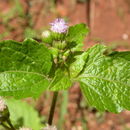pt-BR
nomes no trilho de navegação


Ageratum conyzoides (billygoat-weed, chick weed, goatweed, whiteweed, mentrasto) is native to Tropical America, especially Brazil, and is an invasive weed in many other regions. It is an herb that is 0.5–1 m. high, with ovate leaves 2–6 cm long, and flowers are white to mauve.[3]
In Vietnamese, the plant is called cứt lợn (meaning "pig feces") due to its growth in dirty areas.[4]
As a medicinal plant, Ageratum conyzoides is widely used by many traditional cultures, against dysentery and diarrhea.[5] It is also an insecticide and nematicide.[6][5]
Ingesting A. conyzoides can cause liver lesions and tumors.[7][8] There was a mass poisoning incident in Ethiopia as a result of contamination of grain with A. conyzoides.[9] The plant contains the pyrrolizidine alkaloids lycopsamine and echinatine.
A. conyzoides is prone to becoming a rampant environmental weed when grown outside of its natural range. It is an invasive weed in Africa, Australia, Southeast Asia, Hawaii, and the USA.[10][11] It is considered a moderate weed of rice cultivation in Asia.[12]
Ageratum conyzoides (billygoat-weed, chick weed, goatweed, whiteweed, mentrasto) is native to Tropical America, especially Brazil, and is an invasive weed in many other regions. It is an herb that is 0.5–1 m. high, with ovate leaves 2–6 cm long, and flowers are white to mauve.
In Vietnamese, the plant is called cứt lợn (meaning "pig feces") due to its growth in dirty areas.